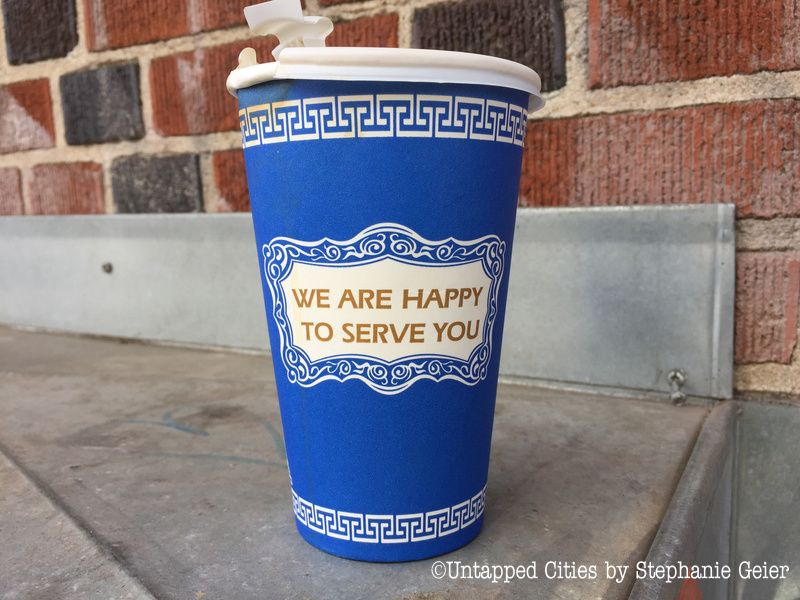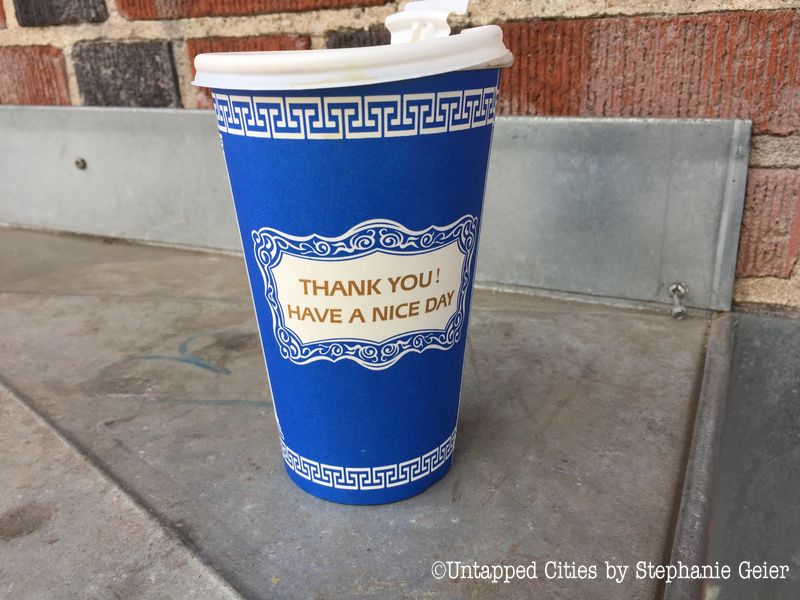Last Chance to Catch NYC's Holiday Notalgia Train
We met the voices of the NYC subway on our nostalgia ride this weekend!


If you’re a New Yorker who enjoys your daily cup o’ joe, at some point you’ve probably sipped from the blue, white and gold Greek coffee cup that reads “WE ARE HAPPY TO SERVE YOU.” Even if you’re not a coffee person, you might’ve seen the cups clutched in the hands of fellow commuters, on the counter of your local bodega, or in shows like Law and Order, Mad Men, and The Sopranos. In fact, the cup might be so familiar that you’ve never stopped to think about why it’s Greek-themed. But no worries—we’re here to tell you why.
New York City’s Greek coffee cups are called “Anthora,” which stems from the Greco-Roman amphora, an ancient container. If you look closely at the cup, you’ll see a picture of an amphora, alongside the cup’s slogan and a Greek key (the decorative border), all in the backdrop of the Greek flag’s blue and white.

The story starts with New York City’s wave of Greek immigrants during the early 1900s, who brought a love for coffee along with them. This precipitated an influx in Greek-owned coffee shops and carts—over 600 of them. In 1963, the Sherri Cup Company created a standard coffee cup to appeal to these Greek food vendors and restaurant owners. The company’s Marketing Director, Leslie Buck, then came up with a warm message for the cups: “We are happy to serve you.” The Anthora soon became New York City’s “go-to” coffee cup.

Explore the Manhattan birthplace of New York City's coffee history while sipping an espresso, drip coffee, and cappuccino from the city's oldest cafes!
Cup sales peaked at 500 million in 1994, with The New York Times describing the cups as “perhaps the most successful cup in history.” In 2003, the a ceramic version of the cup was designed and then sold by the MoMA.
But then the Solo Cup Company bought Sherri in 2005, and sales fell to 200 million. The sales decline was largely due to the 1994 debut of Starbucks in New York City and of course, the influx of other immigrant restaurant owners. What was once the standard coffee cup became a much rarer find. The New York Times even called the Greek coffee cups “one of those endangered artifacts.”

In 2006, Solo Cup ceased its large-scale distribution of the cups, but maintained its iconic design by selling licenses to restaurants and souvenir stores. Finally, after nine years, the Anthora cup officially returned in 2015 and became available to wholesale distributors when the Dart Container Company, who owns the cup, got requests for their comeback. Linda Greenman from Dart announced, “The Anthora became an iconic symbol in and of New York City. Coffee sellers and drinkers don’t have to settle for pretenders anymore. The true Anthora – called iconic, ubiquitous and symbolic in its heyday – is ready to take its place as the comeback cup.”
However, with different cup companies selling them, there is no longer a single model, but different versions. In 2005, The New York Times interviewed a man who collected the Greek coffee cups. His cups had slightly different designs and slogans, with one variation even replacing the amphora with the Statue of Liberty. Yet another version of the cup, produced by Premier Cup, features a discus thrower.

Today, the Anthora is perhaps less common than it was in its earlier days, but nonetheless retains its novelty. NYCoffeeCup calls the cup “The One and Only, Genuine, Original New York Coffee Cup” and prides itself as “the only place to shop for the Original New York Coffee Cup.” It’s fascinating that although the original intentions of Buck and the Sherri Cup Co. were to market to Greek vendors, their creation has become an enduring symbol for New York City in spite of its ups and downs. It has come to represent both the city itself and its identity as a place that welcomes immigrants.
Uncover more NYC coffee history on our Greenwich Village Coffee Tour and Tasting!

Explore the Manhattan birthplace of New York City's coffee history while sipping an espresso, drip coffee, and cappuccino from the city's oldest cafes!
Next, read about the surprising history of the “I Love NY” logo
Subscribe to our newsletter